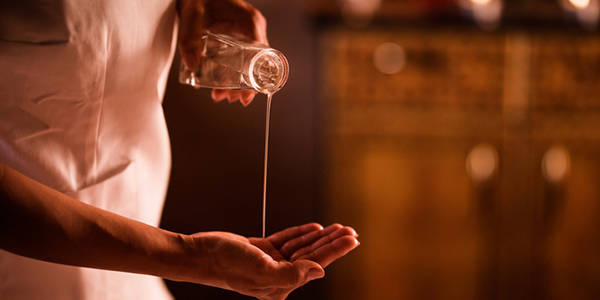Everyone deserves to feel like a king/queen during Diwali, don’t you think? Oils, especially those rich ones for applying on the skin are a part of several old civilizations. There are references to ‘anointing’ in the Holy Bible. Historically, anointing is correlated with conferring of kinghood, across various cultures. That’s the basis of the entire anointing tradition around Diwali. Let’s understand more in this article.
Sanskrit is a “punny” language; there are a lot of words used in Ayurveda and other scientific texts that are used with one meaning and the other meaning is implied (for the wise readers to find out!). One such word is Sneha. Sneha is used for oil/ghee and other fats and is also the word for love/affection. So, why am I bringing that up now, you may ask. It is Diwali time and one of the important traditions with a lot of health wisdom is the “Abhyanga Snaanam” or the oil bath.
[the_ad id=”6076″]
Indian traditions are in sync with the weather conditions around. A change in season calls for a change in the routine. Following the weather calendar and routines suitable to the season is given prime importance in Ayurveda and all this wisdom is cited under the title ‘Ritucharya’ (seasonal routine). One important winter routine is Abhyanga Snaanam.
Technically, Abhyanga Snaanam is a part of the ‘Dinacharya’ (daily routine for all the days of the year); however, it is typically not practiced by people every day anymore. But then, Diwali marks the beginning of winter and the associated dryness and Abhyanga is most beneficial around this time. Abhyanga is an important Diwali tradition in several parts of India, including Maharashtra and Karnataka.
And now for the implied meaning of Sneha which is love and affection; affection is important all year long; however, it is more rampant in this festive season.
Let us have a look at some important pointers around Abhyanga Snaanam then:
What exactly is Abhyanga?
Abhyanga is nothing but a warm oil massage. To start your Abhyanga warm the oil first. Test the temperature of oil, before dipping your hand. The massage oil should not be too hot, just comfortably warm.
Always massage towards the direction of your heart (‘Pratilomam’).
- Apply oil first to the crown of your head- head is the most important. Use circular strokes here
- Face- Equally important. Use circular strokes on your ear lobes, ears, forehead, temples, cheeks, and jaws (in an upward movement).
- Limbs- Use long strokes
- Joints (elbows and knees)- Use circular strokes.
- Abdomen and chest- use broad, clockwise, circular motion.
- Massage both your feet for at least a couple of minutes. This is exceptionally important and is called “Padaabhyanga” in Ayurveda.
Benefits of Abhanga
Maharshi Charak has enlisted the benefits of Abhyanga Snaanam as follows:
“The body of a person, who practices Abhyanga routinely, does not get affected by external trauma or strenuous physical work. The daily Abhyanga provides one with good skin, good physique and the bodily strength. His/her body becomes strong, pleasant to look at, has good lustre and is not affected by old age”.
Abhyanga:
- Provides nourishment to the entire body
- Decreases the ill-effects of ageing
- Increases muscle tone and vigour
- Bestows a firmness to the limbs
- Lubricates the joints
- Improves circulation
- Stimulates the internal organs of the body
- Rids the body of impurities
- Accelerates lymphatic drainage, helping in detoxification
- Upsurges stamina
- Enhances sleep to impart better and deeper sleep
- Enhances vision
- Helps scalp hair grow opulently, improves quality (thickness, softness and lustre)
- Nourishes skin to make it soft, smooth and supple; prevents wrinkles
Choice of oils
Choice of oils depends on the harshness of the winter, individuals prakriti (based on three humors: vata, pitta and kapha), availability in the area, affordability etc. Premium quality oils are Chandan-Bala-Lakshaadi oil, Mahanarayan oil, Dhaanvantar Oil, etc.
Oil pulling
Oil pulling is a part of the Abhyanga. This process is called Kaval/Gandusha in Ayurveda. It gained a lot of popularity lately after celebrities like Shilpa Shetty started vouching for it.
This procedure involves holding and swishing a tablespoon of oil around the mouth, just like you would use a mouthwash. Oil pulling is typically done early in the morning for about 15–20 minutes.
Ayurveda texts mention that oil pulling whitens your teeth, freshens up your breath and greatly improves your oral health. It also helps strengthen cheek muscles and gives facial-like effects to the skin of the face. One may use any edible oil for this- coconut oil and sesame oil are quite popular.
Role of Ubatan
Ubatan is a mix of some aromatic herbs that are great for the skin. Scrubbing the skin after oil application helps remove excess oil from the oil massage. It also removes the dead skin to make skin clean and glowing. Ubatan goes by the Sanskrit name ‘Udvartan,’ and as the name suggests it has to be applied in the direction opposite to that of the hair follicles of the skin. The idea is to cleanse and increase the blood flow to the skin tissue. Regular use of Ubatan helps in getting rid of excessive fat/cellulite, according to Ayurveda.
In case you do not have access to getting traditionally prepared Ubatan, you may opt for a humble Besan (chickpea flour)+ turmeric mixture or masoor flour (split red lentil flour) +turmeric mixture.
Hot water bath
Sit for about 5-15 minutes with the oil, if possible, to allow the skin to absorb maximum oil. A refreshing hot water bath is desirable after a nice oil massage. Be mindful to not use very hot water on the head/scalp. You may want to apply a mild soap, which is not essential if you have used an Ubatan. Pat your body dry gently after the Abhyanga.
Post Abhyanga:
Do not eat a very heavy meal. Go for light meals throughout the day after Abhyanga.
In a nutshell, Abhyanga has great physical and mental health benefits. There is a social health angle to it when it is practiced like a family tradition, especially around Diwali.
So, are you ready to get anointed this year?
Source:

Dr. Mamta Lele- Pawara
(MD Ayurveda-Internal Medicine, CRAV-Kayachikitsa, MA Sanskrit)
